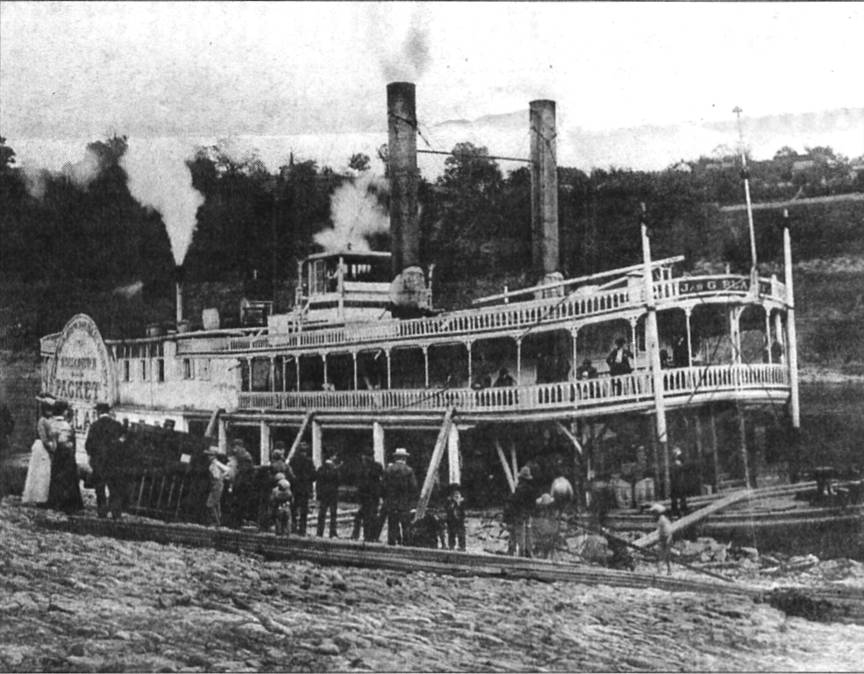
http://www.pittsburghlive.com/x/search/s_329072.html
A New Era: First steamer trip to Morgantown*
Pittsburgh Tribune-Review
1 May 2005
By J.K. Folmar I
The Nov. 14, 1889, issue of The Brownsville Telegraph has a column describing the first field trip up the Monongahela River to Morgantown, W.Va., with the completion of the new locks.

Headlined "First Trip to Morgantown of the Steamer James G. Blaine," the article began, "The splendid electric-light packet, James G. Blaine (named for the Republican politician who grew up in West Brownsville), helmed by Capt. Adam Jacobs, left Pittsburgh last Thursday afternoon for Morgantown, W.Va., making the initial trip to the now headwaters of the Monongahela."
The Blaine's hull was built upriver at East Riverside in Luzerne Township and completed at Brownsville in 1882, including the newfangled electric lights, for the Pittsburgh, Morgantown and Geneva Packet Co. It measured 162 feet by 34 feet by 5.5 feet and had 40 staterooms and 86 berths.
"Morgantown," the article continued, "is 105 miles (actually 101) from its mouth at Pittsburgh, 48 miles from here and 16 above (New) Geneva. For many years efforts have been made to have the slackwater extended to this important point and about nine years ago dam No. 9 (mile 93) was completed by the state of West Virginia, but was of little use until the general government completed No. 8 (mile 87) at the month of Dunkard (Creek), which work has been prosecuted with that slow but sure process, characteristic of government work.
"Under the superintendency of Col. (William E.) Merrell (Merrill) the dam and lock now stand as one of the best pieces of masonry and completeness in the world -- he having traveled extensively, both at home and abroad and utilized his experience on this work."
The Monongahela Navigation Co. had completed the "slackwater" system of seven locks upriver to Lock 7 at mile 83, near Jacob's Creek, in 1883.
The article continued, "Notwithstanding the very inclement state of the weather, a number started from the city, and as the fine steamer proceeded up the river the crowd was augumented (sic) until she presented the appearance of an excursion steamer.
"The Arlington Band discoursed charming music along the river and the high hills echoed back the sweet strains. As the coming of the steamer and the strains of music drew the overjoyed people to the shores, many anxious to make the first trip to Morgantown, and scene after scene of beauty came into sight, the crowd got jolly and the fermentation of Pennsylvania and West Virginia 'mountain dew' caused the boys to get elated and the crowd became one surging mass.
"After making a close inspection of the new lock, opposite Dunkard, we passed through, and points of interest were reached in rapid succession. One of these was Point Marion, where the famous Cheat River flows into the Monongahela and an extensive timber boom is built. Crooked Run is also of interest as it becomes the state line back from the river, a rail fence carrying the eyes way up near the heavens, being the line as viewed from the decks of the boat. This is on the Greene County, Pa., side of the river, while a very crooked tree -- crooked as Virginia politics -- marks the point on the opposite side of the river in West Virginia.
"Next we come to Lock No. 9. This piece of work shows that poor stone were used in its walls or else it has been very poorly cared for as the walls are scaled like some of the oldest locks near Pittsburgh. Mr. Howard passed us through and we proceeded to Every and then on to Collins Ferry. Perhaps Oliver Baldwin would find 'Tom' there. Speeding on, gathering new crowds at the various points, we pass Randall and soon come to Granville. This place is not very large but it has natural gas and an island -- the only island in the Monongahela River. But the 'Athens of West Virginia' now heaves in sight, the James G. Blaine opens up her steam whistle -- everything in the city that can make noise seems to be brought into requisition in response and as we dropped into the landing the good citizens -- young and old -- pretty girls and genteel looking boys, many from the surrounding country, greeted us with cheer after cheer. Everybody was glad but the rain was so heavy that the proposed reception was spoiled, but the warm greeting of the people could be seen in every nod and handshake and cheer.
"Capt. Jacobs, Clerk Conley and the rest of the crew seemed to enjoy the trip and spared no effort to make it a memorable one in the annals of navigation on the beautiful Monongahela, and they anticipate a large travel from the headwaters now opened up."
It was signed "R.B."
By 1903 six more locks were built the 25 miles to Fairmont, making all-year navigation possible for the first time on the Monongahela River.
* This is the first steamer trip to Morgantown after the completion of the locks. The first steamboat to reach Morgantwn was the Reindeer, in 1826.